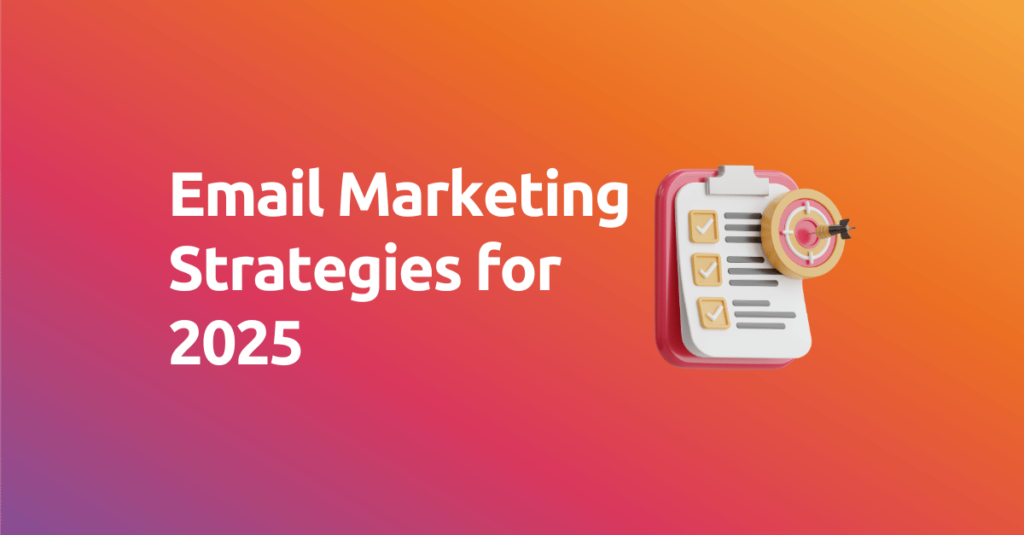Introduction
In 2025’s ultra-connected digital era, email marketing remains a powerhouse for driving ROI—and smarter, more personalized strategies are taking it to new heights. Today’s savvy marketers need strategies that blend AI, interactivity, and compliance into seamless campaigns. This article unveils the top email marketing strategies for 2025, helping you cut through inbox clutter and win hearts—and conversions.

H2: 1. AI-Powered Personalization & Predictive Campaigns
H3: Hyper-Personalized Content with AI
Artificial Intelligence, particularly generative AI and predictive analytics, is revolutionizing how we tailor emails. Predictive models now analyze past behaviors to forecast preferences—delivering content that truly resonates with individual subscribers WikipediaBusiness Insider.
Yum Brands (Taco Bell, KFC) reports that AI-driven emails—timed and customized per user—have increased engagement and reduced churn The Wall Street Journal.
H3: AI for Efficiency in Creation
Thanks to AI, content creation is faster and more dynamic. Tools now assist in drafting subject lines, body copy, images, and even video clips—freeing marketers to focus on strategy and creativity Litmus.
H2: 2. Advanced Segmentation & Lifecycle Automation
H3: Smarter Segmentation
Segmenting your list—by demographics, purchase behaviors, or engagement patterns—boosts performance dramatically. In fact, segmentation is consistently among the top tactics for email effectiveness MailerLitePorch Group MediaLitmus.
H3: Lifecycle & Drip Campaign Automations
Automated workflows (e.g., welcome series, re-engagement drips) guide subscribers through your funnel with precision. While they free up resources, automations must be finely tuned to avoid errors and ensure engagement LitmusWikipedia.
H2: 3. Interactive & Immersive Emails
Marketers are embracing interactivity—quizzes, surveys, carousels, gamified elements—to boost engagement. Interactive emails offer real-time feedback and deeper personalization MailerLite.
Enhanced interactivity (like AMP for Email) continues to gain interest—delivering experiences that engage more than just clicks Litmus.
H2: 4. Automation—Backbone of Scalable Campaigns
H3: Accelerating Production
With automation, marketing teams that once needed two weeks per email campaign can scale to more agile workflows—automating design, testing, scheduling, and analysis Litmus.
H3: Automation’s Revenue Edge
Automated emails generate up to 320 % more revenue than non-automated ones, making automation not just efficient, but profitable OptinMonster.
H2: 5. Compliance, Privacy & Trust
H3: Privacy-Proof Your Strategy
With tightening regulations and increasing user concerns, privacy must be baked into your email strategy. Transparency—especially around AI use—can build trust and distinguish your brand MailerLiteBusiness Insider.
Litmus highlights the growing importance of privacy-proofing for long-term email success Litmus.
H3: Deliverability & Ethical Practices
Avoid over-emailing, comply with data laws, and prevent spam complaints. For instance, Mailchimp’s partnership with Canva focuses on compliance and predicting over-emailing The Australian.
H2: 6. Enhanced Analytics & Intelligent KPIs
H3: Move Beyond Open Rates
Open rates are increasingly unreliable due to default image blocking and privacy shifts. Forward-thinking marketers prioritize metrics like click-through rate (CTR), conversions, unsubscribe rates, and revenue per email (RPE) Litmus.
H3: Unified Data Strategy
Consolidating and tracking KPIs across platforms enables smarter segmentation, better content decisions, and higher ROI Litmus.
H2: 7. ROI & Engagement: Why Email Still Wins
Email continues delivering unmatched ROI—$36 for every $1 spent—and remains one of the most profitable channels for marketers ShopifyLitmus.
Conversion rates average ~2.8% (B2C) and 2.4% (B2B), placing email at the top of marketing efficiency rankings HubSpot.
H2: 8. Growth in Email Usage & Engagement Trends
- User Base Expansion: Nearly 4.5–4.6 billion people use email in 2025, projected to reach over 4.8 billion by 2027 OptinMonsterOmnisendSixth City Marketing.
- Daily Email Volume: Around 376 billion emails are sent daily, climbing toward 408 billion by 2027 EmailTooltester.comOptinMonster.
- Mobile Dominance: With 50% of recipients deleting unoptimized emails, mobile-friendly design isn’t optional—it’s essential OptinMonster.
H2: 9. Combining Channels for Deeper Reach
Forward-moving strategies blend email with SMS, push notifications, and cross-channel orchestration via AI—boosting engagement while honoring user preferences and privacy arXivReddit.
Conclusion
In 2025, the most powerful email marketing strategies are ones that embrace AI, interactivity, automation, privacy, and agile data insights. Here’s what to prioritize:
- AI-first personalization
- Lifecycle automations & segmentation
- Interactive content formats
- Automation for scale & efficiency
- Privacy-forward and transparent practices
- KPI-based analytics (beyond opens)
- Mobile optimization
- Cross-channel cohesion
Call to Action: Start experimenting today—set up a simple automated lifecycle workflow, A/B test interactive emails, or pilot AI-generated subject lines. Your audience—and your ROI—will thank you.
Internal Linking Suggestions
(Use natural-sounding anchor text to link to these hypothetical pages on your site):
- “email personalization techniques” (link to /internal/email-personalization)
- “marketing automation best practices” (link to /internal/automation-tips)
- “interactive email design ideas” (link to /internal/interactive-email-design)
External Links to Authoritative Sources
- Litmus report on email trends and AI adoption in 2025 Litmus
- HubSpot’s 2025 data on email conversion rates HubSpot
Alt Text for Images (for accessibility & SEO)
- “AI-generated email workflow example illustrating lifecycle automation and segmentation”
- “Interactive email template with quizzes and carousels for 2025 email marketing”
- “Mobile email display optimized for 2025 readers navigating on phones”
Mobile-Friendly & Readability Tips
- Keep paragraphs short.
- Use headers (H2, H3) and bold key phrases for mobile scanning.
- Include bullet lists to break up dense information.
- Ensure fast loading by avoiding bulky images—opt for optimized visuals or GIFs
